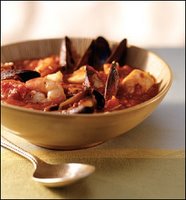
My one and only childhood friend of memory visited me this weekend. Jennifer and I were best friends when we were 12 and 13…and then I moved away. But she stands out in my memory as the best friend I ever had, and it was absolutely delightful to see her again.
Stuck for something to cook for dinner on Friday night, we wandered into the grocery store for inspiration. The seafood counter had loads of lovely fresh live mussels and clams, and some fresh local halibut as well. Rather than have to choose, I decided to whip together some amazing San Francisco Cioppino with all of the above.
Cioppino is one of the few genuinely unique San Francisco dishes. It’s neither Italian nor Portuguese, but concocted by fishermen who came from the Mediterranean to the Bay Area in the 1800s. Inspired by ethnic origins but leveraging local abundance, Cioppino truly reflects the diversity and bounty of San Francisco.
For a proper Cioppino, you need to create a tomato broth with plenty of local herbs, garlic, and wine, and then add to it whatever local seafood is currently fresh and on hand. The dish should include a few types of shellfish, in addition to some sort of reasonably strong-fleshed white fish. Mussels, clams, prawns, and crab work incredibly well for the shellfish, and rockfish (including Pacific Red Snapper) or halibut are often used for the fish. You can also add abalone, squid, and octopus. It should be served like a stew, with plenty of San Francisco sourdough bread on hand to mop up the glorious broth.
This recipe was perfect for 4 hungry people.
For the sauce:
- Butter & Olive Oil (my brother’s favorite combo)
- Garlic, at least one whole bulb, crushed
- 1 grated carrot
- 1 sweet yellow onion, finely chopped
- 1 small green bell pepper (can also use mild green chilis), finely chopped
- A few stalks of celery, finely chopped
- Fresh herbs on hand: basil, parsley, oregano or marjoram, thyme, bay leaf + fennel seed, black pepper, a dash of crushed red pepper
- 2 x 16oz cans of chopped or crushed tomatoes
- 3 x 8oz cans of tomato sauce
- 2 x 8oz bottles of clam juice (Sure, you could use fancy gourmet fish stock. But it wouldn't taste much differently)
- 2-3 bottles of Sauvignon Blanc (1 for the Cioppino, the rest to drink)
Heat the butter & olive oil, and sauté the onion until translucent. Add bell pepper, carrot, and celery, and sauté until soft. Add garlic and herbs and sauté until the aroma is heavenly. Deglaze the pan with a good splash of white wine, and then add tomatoes and tomato sauce, and the clam juice. Leave to simmer for at least an hour, adding water if/when necessary to maintain a fairly thin, souplike consistency.
The seafood:
Choose three or four of the items below. I used 8oz each of clams, mussels, halibut, and prawns.
- ½ lb mussels, clams, or limpets
- 4 oz prawns, langostine, or crayfish, cleaned, shelled, deveined. Tails can be left on or removed but they should at least be shelled.
- a small Dungeness crab (I suppose if you’re not in SF, you can substitute something else). Be sure to pre-crack legs and claws
- 4 oz well pounded octopus, squid, or abalone, chopped into bite-sized pieces
- 4 oz nice, firm, white fish like rock fish or halibut, chopped into 1” cubes
- 4 oz scallops
No comments:
Post a Comment